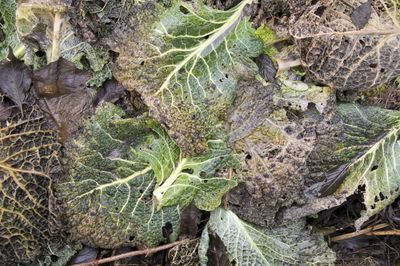When fungal diseases, such as tar spot or powdery mildew, are in an area, unless your landscape is in its own protective bio-dome, it is susceptible. You can take preventative measures, treat your own plants with fungicides and be religious about garden clean up, but you can’t catch every airborne spore or infected leaf that may blow into your yard. Fungus happens. So what do you do in autumn when you have a yard full of fungal infected fallen leaves? Why not throw them in the compost heap.
Can I Compost Diseased Plant Leaves?
Composting diseased leaves is a controversial subject. Some experts will say throw everything in your compost bin, but then contradict themselves with “except…” and list off all the things you shouldn’t compost, like foliage with pests and disease. Other experts argue that you really can throw EVERYTHING on the compost pile as long as you balance it with a proper ratio of carbon rich ingredients (browns) and nitrogen rich ingredients (greens) and then give it enough time to heat up and decompose. By hot composting, pests and diseases will be killed off by heat and microorganisms. If your yard or garden is full of fallen leaves with tar spot or other fungal diseases, it is essential to clean up these leaves and dispose of them somehow. Otherwise, the fungi will just lay dormant through winter and as temperatures heat up in spring, the disease will once again spread. To dispose of these leaves, you only have a few options.
You can burn them, as this will kill off the pathogens that cause disease. Most cities and townships have burning ordinances, though, so this isn’t an option for everyone. You can rake up, blow and pile all the leaves and leave them at the curb for the city to collect. However, many cities will then put the leaves in a city run compost pile, which may or may not be processed correctly, can still carry disease and is sold cheap or given away to city residents. The last option is you can compost them yourself and ensure pathogens are killed off in the process.
Using Diseased Leaves in Compost
When composting leaves with powdery mildew, tar spot or other fungal diseases, the compost pile must reach a temperature of at least 140 degrees F. (60 C.) but no more than 180 degrees F. (82 C.). It should be aerated and turned when it reaches about 165 degrees F. (74 C.) to allow oxygen in and to mix it around to thoroughly heat up all the decomposing matter. To kill off fungal spores, this ideal temperature should be kept for at least ten days. For materials in a compost pile to process correctly, you need to have the proper ratio of (brown) carbon rich materials such as autumn leaves, corn stalks, wood ash, peanut shells, pine needles, and straw; and the proper ratio of (green) nitrogen rich materials such as weeds, grass clippings, coffee grounds, kitchen scraps, vegetable garden waste and manure. The suggested ratio is about 25 parts brown to 1 part green. Microorganisms that break down composted materials use carbon for energy and use nitrogen for protein. Too much carbon, or brown materials, can slow down decomposition. Too much nitrogen can cause the pile to smell very bad. When putting leaves with fungus in compost, balance these browns with the proper amount of greens for best results. Also, be sure the compost pile reaches the ideal temperature and stays there long enough to kill off pests and diseases. If diseased leaves are composted properly, the plants you place this compost around will be far more at risk of contracting air borne fungal diseases then catching anything from the compost.
